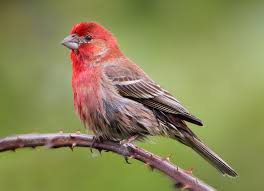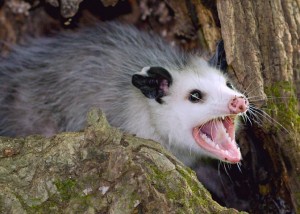Prey animals are forced to employ various mechanisms of predator detection in order to avoid being eaten. Methods of detection can vary, and many animals can use multiple sensory modalities to perceive the presence of a predator. One possible means of detection is olfaction, the ability to identify predator scents when they are in the area. Though this can be a useful adaptation, it has also been hypothesized that this can be energetically costly if it causes prey to avoid an area in which a predator is no longer present or is attempting to attack. For example, omnivorous predators can have different prey needs based on recent diet, so the ability for prey to detect recent dietary cues of predators could be beneficial in preventing unnecessary avoidance behaviors if the predator is not currently a threat.
In order to test thee phenomena, Amo et al. (2015) examined avoidance behaviors in the house finch Carpocadus mexicanus to urine scents of common oppossums. The house finch is a small, monogamous songbird that has been extensively studied for their mating behavior, which depends on honest red coloration signals in the males. The species has been shown to use olfaction in social interactions.
 “Look how red and attractive I am.” – male house finch
“Look how red and attractive I am.” – male house finch
The researchers performed two experiments. The first tested whether the birds could actually detect the olfactory cues of the marsupial predator and whether they avoided the scent. The second tested whether there was a difference in avoidance strategy based on the recent diet of the predators. They hypothesized that the finches would detect and avoid areas marked with opossum urine, and that they would display different avoidance behaviors depending on predator diet.
The researchers collected the urine of opossums through traps with different kinds of bait, chicken and fish. The traps contained absorbent paper to absorb urine. In the first experiment, finches were placed in two-chambered containers, one chamber containing the urine paper and the other sprayed with a different novel scent, cologne. The chamber preference of the finches upon release was recorded and analyzed for significance. A similar test was performed for the second experiment, in this case with each chamber containing the urine of opossums with different diets.
Results showed that the finches did in fact avoid spaces with predator urine over spaces without predator cues. This indicates that house finches do employ olfactory modes of predator detection and avoidance. The researchers suggested that there is perhaps a sulphurous compound produced by meat digestion that is excreted in urine and can warn prey of carnivorous or omnivorous predators. The results of the second experiment, however, did not agree with the hypothesis, with the finches showing no differential responses to the urine of chicken or fish fed opossums. The researchers conclude that this is perhaps due to the omnivorous and opportunist nature of the predator, which will perhaps prey on the finches regardless of recent diet, leading to no advantage in response to different dietary olfactory cues. These results provide a good example of olfactory detection in birds, but more study would be needed in order to fully understand the predator detection mechanisms of house finches.
Amo, Luisa, et al. “Evidence that the house finch (Carpodacus mexicanus) uses scent to avoid omnivore mammals.” Revista chilena de historia natural 88.1 (2015): 5.

